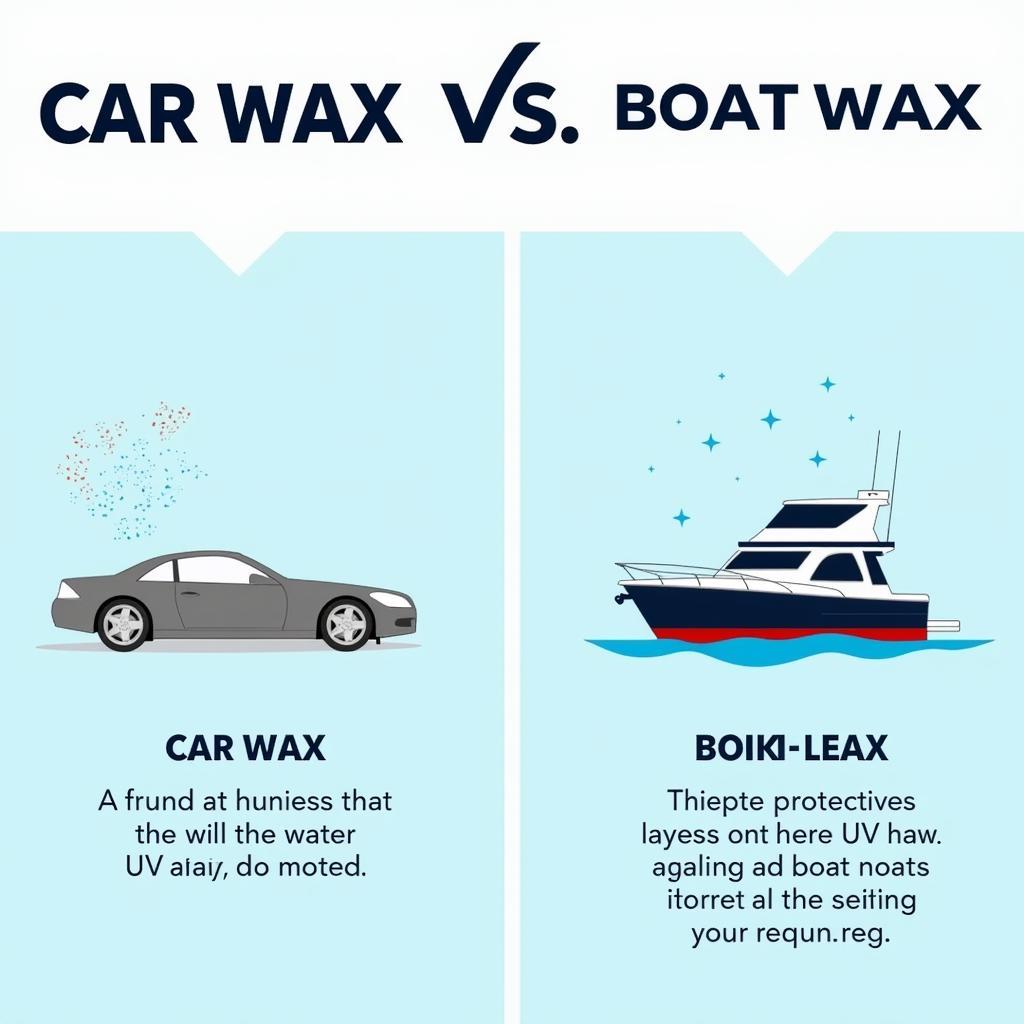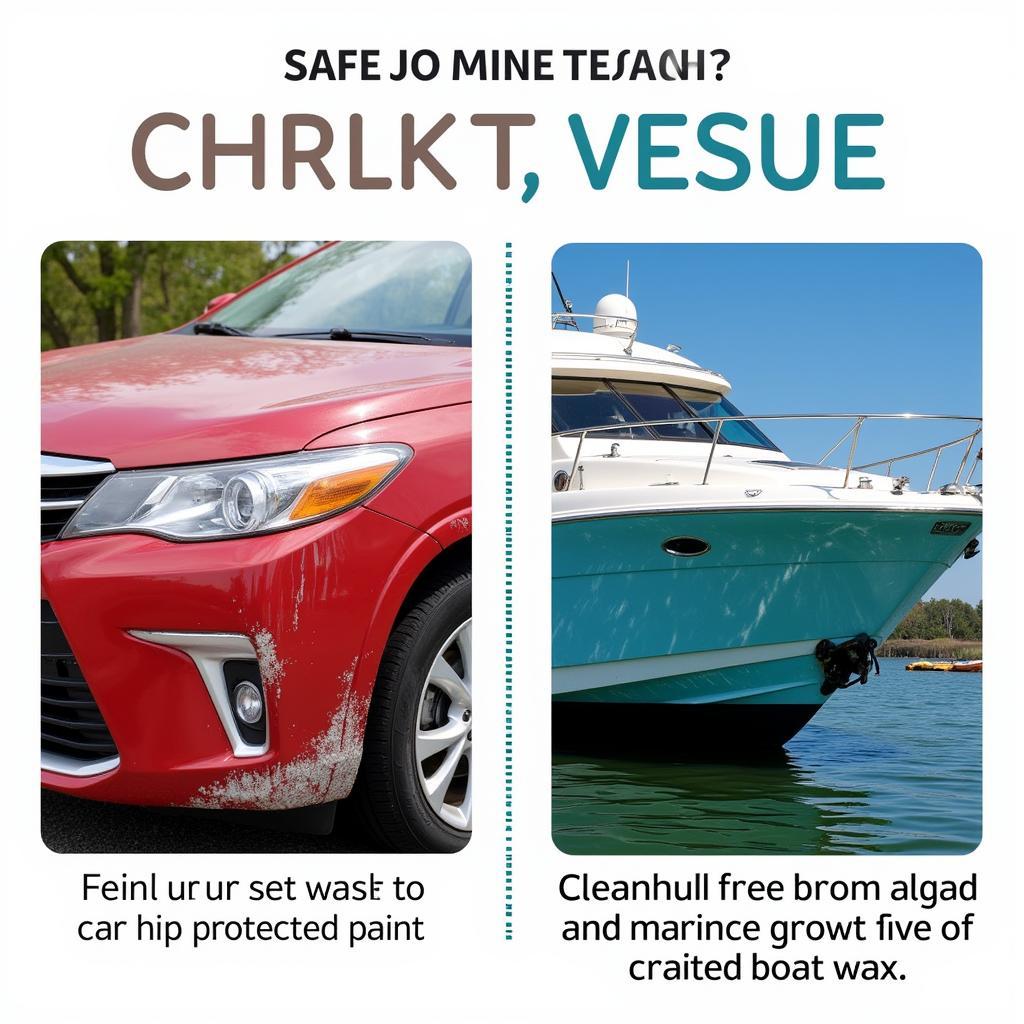Car and boat wax are both designed to protect surfaces and add shine, but are they interchangeable? The simple answer is no. While they might seem similar, there are key differences between car wax and boat wax stemming from the distinct environments they’re designed to withstand. Understanding these differences is crucial for proper vehicle maintenance and achieving optimal protection.
Why Car and Boat Wax Aren’t Interchangeable
While both car and boat waxes protect against the elements, the type of elements they combat differ significantly. Cars primarily face road grime, UV rays, and occasional rain. Boats, however, contend with harsh marine environments, including prolonged saltwater exposure, intense sun, and marine growth. This requires a different formulation for effective protection. Using car wax on a boat won’t offer adequate protection, and using boat wax on a car can be overkill and potentially damaging.
Chemical Composition and Protection Levels
Car waxes often contain natural or synthetic polymers, designed to bond with the car’s paint and provide a hydrophobic layer that repels water and dirt. They offer good UV protection, preventing the paint from fading and oxidizing. Boat waxes, on the other hand, typically incorporate stronger UV inhibitors and often contain mildew and algae inhibitors to combat the marine environment’s unique challenges. They also require a higher degree of water resistance to cope with constant contact with water. Think of it this way: car wax is like a light raincoat, while boat wax is like a heavy-duty waterproof jacket.
 Comparing Car and Boat Wax: Chemical Composition and Protection Levels
Comparing Car and Boat Wax: Chemical Composition and Protection Levels
Surface Compatibility and Application
Another critical difference lies in the surface materials. Car wax is formulated for automotive paint, which is a relatively smooth and uniform surface. Boat surfaces can vary significantly, ranging from gelcoat and fiberglass to painted metal and wood. Boat wax needs to be versatile enough to adhere to and protect these diverse materials. Applying car wax to a gelcoat surface, for instance, might not bond properly and could even leave a hazy residue. Conversely, applying boat wax to a car’s paint might be too abrasive and could dull the finish. Similarly, the application methods can differ. While both can be applied by hand or with a machine, boat waxes are often designed for easier application in challenging marine environments.
Is Detailing a Boat the Same as a Car?
This question is often asked, and the answer again is no. is detailing a boat the same as a car While some steps overlap, such as washing and drying, the processes differ due to the specific needs of each vehicle type. Boat detailing involves addressing issues like barnacle removal, algae cleaning, and specialized gelcoat restoration, which are not relevant to car detailing. Conversely, car detailing focuses on paint correction, interior cleaning, and engine bay detailing, which are less critical for boats. Understanding these distinctions will help you choose the appropriate products and techniques for optimal results.
Long-Term Effects and Maintenance
The longevity of car and boat wax also varies. Car wax typically lasts a few months, requiring reapplication every three to six months depending on environmental factors. should i detail my car before long road trip Boat wax, due to the harsher conditions it faces, usually needs more frequent reapplication, especially if the boat is regularly used in saltwater. Proper maintenance and regular waxing are crucial for preserving the finish and protecting both cars and boats from long-term damage.
 Long-Term Protection: Car Wax vs. Boat Wax
Long-Term Protection: Car Wax vs. Boat Wax
Can You Use Car Wax on a Boat or Boat Wax on a Car?
While technically possible, using car wax on a boat offers insufficient protection against the harsh marine environment. is there a difference between detailing car and boat The boat will be more susceptible to saltwater damage, UV degradation, and marine growth. Using boat wax on a car is less detrimental, but it might be unnecessarily abrasive and could dull the finish over time. will a car detail remove water stains It’s always best to use the appropriate product for the intended surface to ensure optimal protection and maintain the finish.
In conclusion, understanding the key differences between car and boat wax is crucial for protecting your investments. While both offer protective qualities, their formulations and intended applications are distinct. Using the correct wax ensures your car or boat receives the specialized protection it needs to withstand its specific environment and maintain its appearance for years to come.
FAQ:
- What is the main difference between car and boat wax? Boat wax is designed for harsher marine environments, including prolonged saltwater exposure.
- Can I use car wax on my boat’s fiberglass? While possible, it’s not recommended as car wax doesn’t provide adequate protection for boats.
- How often should I wax my boat? More frequently than a car, especially if used in saltwater.
- What happens if I use boat wax on my car? It might be too abrasive and potentially dull the finish over time.
- Why does boat wax need mildew inhibitors? To protect against marine growth common in boat environments.
- What are the key ingredients in car wax? Often polymers, designed to provide a hydrophobic layer and UV protection.
- Is boat detailing more complex than car detailing? Both have unique challenges, but boat detailing often involves specialized procedures like barnacle removal.
When you need assistance, please contact WhatsApp: +1(641)206-8880, Email: [email protected]. We have a 24/7 customer support team.

Leave a Reply